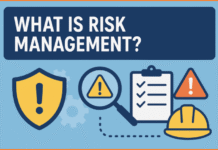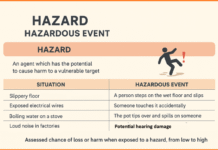Contents
Risk assessment
Procedure of Risk Management is Stated below which includes Risk Analysis Assessment.
Five steps for risk assessment as per HSE (U.K) guidelines
(Qualitative):
- Look for the hazard.
- Decide who might be harmed and how.
- Evaluate the risk and decide whether the existing precautions are adequate or whether more should be done.
- Record your findings.
- Review your assessment and revise it if necessary.
These steps suggest simple method of risk Assessment for any hazardous activity.
It is qualitative only. No factor is quantified. Effect of control measure is taken into account.
Five steps as per Defined Risk Assessment Methodology (Qualitative and Quantitative):
- Identification of hazard and their causes. It is qualitative. HAZOP this step is known as Hazard Identification.
- Analysis of – Mechanism of hazard occurrence and terminal consequence of hazard. This is quantitative eg. HAZAN. Consequence analysis quantifies concentration, deaths, injuries, and damage (damage distance and effect).
- Probability, frequency or likelihood of the hazard occurring and thence an estimation of risk.This is also quantitative as it depends on failure rates, a number of chances or cycles, and reliability engineering.This step is known as Risk Analysis
- Judgment of acceptability of risk against legal, social or political criteria.Here the measured value of hazard or calculated risk is compared with permissible safe limit (Sch.2 Factory Act, GPCB norms etc.) and then the inference is drawn whether hazard or risk is higher or lower than the permissible safe limit or standard.
Therefore this is usually quantitative this step is known as Risk Assessment.
- Decision making and taking control measures to prevent, reduce or transfer the risks by short and long term planning.
This is a mixture of qualitative and quantitative criteria. This step is known as Risk Management, Risk or Safety management should assist the top management in this regard.
Types or Methods of Risk Assessment:
Simple or Qualitative Risk Analysis:
It is an identification of hazards and taking appropriate control measures. Here quantification of hazard and their terminal consequences (damage, distance, the severity of injury or loss etc,) are not worked out.
It is sufficient to think about the adequacy of existing control measure, hazards identified and to adopt more safety measure if necessary.
It’s an important aspect is to consider the effect of control measures provided (in place) and to think for the Residual Risk and Residual Control Measure Only.
2. Quantitative Risk Assessment:
Here hazard potential is quantified, the possible risk is also determined if failure rate data available and then it is compared with the permissible standard this will indicate whether the calculated risk is lower or higher than the permissible limit. Based on this new control measures or modification in existing control measures can be decided.
Values of following “Hazard potentials” can be quantified-
- Properties of the material.
- Storage parameters.
- Process parameters.
- Manual exposures.
- Visible or measured hazards.
- Transportation hazards.
- Pollution hazards.
These values give severity part of the risk. Similarly, values give severity part of the risk Similarly values of control Measures provided can be quantified depending on the poor controls to the best controls.
Proper classification of a good, better, and best control measures, is necessary. These values give probability part of the risk.
Then by using the formula Risk = Severity * Probability the existing risk level can be calculated and identified as low, high, higher or highest risk.
This method is useful to carry out material-wise risk assessment. This method and other methods using ranking matrix are used to carry out activity-wise risk assessment also.
Other Methods of risk assessment.
There are two methods for risk assessment:
- Method based on the formula of Risk R=Probability *Severity. This method is mostly useful for assessing risks to workers in the factory. Hazards are considered material-wise or activity and sub-activity-wise.
- Method based on computer model. This method is mostly useful for accessing risks to public in the vicinity. Gas dispersion models are used and toxic concentration or/and heat radiation effect or/and explosion overpressure effect at a different distance (damage distance) are calculated.
Here it is assumed that if all or some control measure may fail what would be the highest risk (mostly to the public) in terms of toxic effect, fire and explosion or BLEVE effect and at what distance.
This calculation is very complex needs source strength calculation leak hole or release dimension, mass released or released rate, wind speed, weather conditions and classification, path obstructions or sinking mechanism, dispersion calculation, and use of computer models. Safety, phast, aloha, cirrus, archie, IIT-KANPUR, Whazan, effect etc. are such computer models for assessment of this type of risk. Lastly foot prints and risk counter are to be interpreted. Risk counters plotted on geographical plot plan can give Arial view of the area likely to be affected and decision for evacuation or stay in condition.
Main purpose of this type of risk assessment is to assess the risk to the public and to make off-site emergency plan based on those risks.
Risk Counters (foot prints):-
In case of toxic dispersion, normally three zones are considered. The inner most or zone-1 contains the highest concentrations of leaking gas wherein maximum fatality/injury can be predicted. No entry or no rescue operation may be possible there. Then in intermediate or zone-2, evacuation becomes most necessary and must be carried out at the earliest possible otherwise great fatalities or/and injuries may result. This is the target area of emergency planning and rescue activities. But in doing so use of necessary personal protective equipment and vehicles is to be done very carefully. The outermost or zone-3 is safe zone but it can be affected also if dispersion aggravates or last for a longer time. Therefore alert and warning action is required in this zone. People must be advised to go away by their own arrangement and should be helped if necessary.
Failure Mode and Effect Analysis (FMEAJ):-
This procedure considers each component of a plant in turn and all possible failure modes and rates and their consequences. The results are recorded in a standard format. HAZOP study is a well developed form of FMEA.
It is process of hazard identification where all known failure modes of components or features of system are considered in turn and undesired outcomes are noted.
It is a tabulation of system/plant equipment failure modes. Each failure mode assigns critical ranking. Human error/operational error is not generally examined in FMEA.
This is the method derived from reliability engineering. A product or piece of complex equipment is dived in its components and each component is studied to know how it can fail, what rate and what could be the effect on it or on the other components. Failure rate of each item are determined and listed. The method is used to determine satisfactory operational life of equipment, how failure might occur, modes and frequencies of failure and the necessity for proper and timely maintenance and replacement. This knowledge can be used to improve the life and quality of the product. Thus it is primarily more useful to manufacture than its user.
FMEA has its own limitation. Data, of failure rates and calculations for failure frequency must be correct. The method cannot analyze the problem created by bad design, adverse environment and operator’s errors.
If you like this article (risk assessment), Please share with your HSE friends.






Excellent information